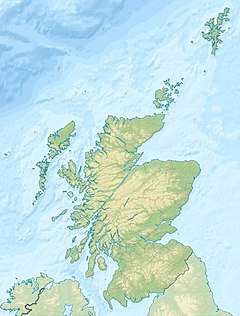Elie
| Elie and Earlsferry | |
|---|---|
| Elie and Earlsferry shown within Fife | |
| Population | 940 (2004) |
| OS grid reference | NO4900 |
| Council area | |
| Lieutenancy area | |
| Country | Scotland |
| Sovereign state | United Kingdom |
| Post town | Leven |
| Postcode district | KY9 |
| Dialling code | 01333 |
| Police | Scottish |
| Fire | Scottish |
| Ambulance | Scottish |
| EU Parliament | Scotland |
| UK Parliament | |
| Scottish Parliament | |

Elie Ness Lighthouse
|
|
|
Scotland
|
|
| Location | Elie Ness Fife Scotland United Kingdom |
|---|---|
| Coordinates | 56°11′02″N 2°48′46″W / 56.183987°N 2.812717°W |
| Year first constructed | 1908 |
| Construction | masonry tower |
| Tower shape | cylindrical tower with balcony and beacon (lantern removed) |
| Markings / pattern | white tower, black trim |
| Height | 11 metres (36 ft) |
| Focal height | 15 metres (49 ft) |
| Light source | mains power |
| Range | 18 nautical miles (33 km; 21 mi) |
| Characteristic | Fl W 6s. |
| Admiralty number | A3060 |
| NGA number | 2552 |
| ARLHS number | SCO-074 |
| Managing agent | Forth Ports |
Elie and Earlsferry is a coastal town and former royal burgh in Fife, and parish, Scotland, situated within the East Neuk beside Chapel Ness on the north coast of the Firth of Forth, eight miles east of Leven. The burgh comprised the linked villages of Elie and Earlsferry, which were formally merged in 1930 by the Local Government Act of 1929. To the north is the village of Kilconquhar and Loch of Kilconquhar.
The civil parish has a population of 861 (in 2011).
Earlsferry, the older of the two villages, was first settled in time immemorial. It is said that MacDuff, the Earl of Fife, crossed the Forth here in 1054 while fleeing from King Macbeth. In particular the legend tells of his escape being aided by local fishermen, an act which may have led directly to the village being promoted to royal burgh status due to MacDuff's later influence over Malcolm III.
By the middle of the 12th century, the Earls of Fife had instituted a ferry for the use of pilgrims en route to the shrine of Saint Andrew the Apostle at St Andrews. The ferry crossed the Firth of Forth to North Berwick, a distance of 7 miles, and it is this ferry that led to the naming of the place. There are the remains of a small chapel on Chapel Ness, built for the use of these pilgrims.
The exact date of Earlsferry being made a Royal Burgh is unclear as its original charter was destroyed in a fire. It became a trading port for merchants and remained so until the 18th century, and was also an important calling point on the pilgrims' route from the south to St Andrews. A new charter was granted in 1589. Little is known of the foundation of Elie, but it had become sufficiently important to merit the building of Elie Parish Church in 1639. Its harbour was more sheltered than that of Earlsferry and it began to poach trade away from Earlsferry.
...
Wikipedia


